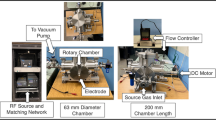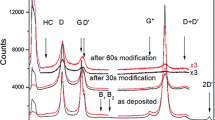Abstract
Plasma-chemical bromination applied to graphitic materials, in particular to highly ordered pyrolytic graphite is reviewed. The resulting bromination efficiency of the plasma-chemical treatment was subject of systematic process optimization. The plasma of elemental bromine vapour produced bromine concentrations on graphene surfaces of more than 30 % Br/C using either inductively or capacitively coupled low-pressure radio-frequency plasmas. Plasma brominated graphite surfaces have been studied by Near Edge X-ray Absorption Fine Structure, X-ray Photoelectron Spectroscopy, Atomic Force Microscopy and Scanning Electron Microscopy. The introduction of bromine into graphene-like graphite layers and its binding situation were investigated. To study the physical effect of the plasma bromination process, Kr plasma was also used because of its chemical inertness but similar atomic mass. Covering the samples with a Faraday cage or with a LiF window should help to differentiate between physical, chemical and radiation effects of the plasma. Bromination was assigned to radical or electrophilic addition of bromine onto fully substituted aromatic double bonds (sp2 C) with exothermal reaction enthalpy. Low bromination shows a strong decay of aromatic double bonds, higher bromination percentage let disappear all aromatic rings. The formed C–Br bonds were well suited for efficient grafting of organic molecules by post-plasma wet-chemical nucleophilic substitution. This grafting onto the graphene surface was demonstrated using aminosilane and different diamines. The bromination of double bonds changes the hybridization of carbon atoms from plane sp2 to tetrahedral sp3 hybridization. Thus, the plane topography of graphene is destroyed and the conductivity is lost.


















Similar content being viewed by others
References
Georgakilas V, Otyepka M, Bourlinos AB, Chandra B, Kim N, Kemp KC, Hobza P, Zboril R, Kim KS (2011) Functionalization of graphene: covalent and non-covalent approaches, derivatives and applications. Chem Rev. doi.10.102/cr3000412
Salvagione HJ, Martinez G, Ellis G (2011) Recent advances in the covalent modification of graphene with polymers. Macromol Rap Comm 32:1771–1789
Friedrich JF, Wettmarshausen S, Hanelt S, Mach R, Mix R, Zeynalov E, Meyer-Plath A (2010) Plasma-chemical bromination of graphitic materials and its use for subsequent functionalization and grafting of organic molecules. Carbon 48:3884–3894
Poh HL, Simek P, Sofer Z, Pumera M (2013) Halogenation of graphene with chlorine, bromine, or iodine by exfoliation in a halogen atmosphere. Chem Eur J 19:2655–2662
Gopalakrishnan K, Subrahmanyam KumarP, Govondaraj A, Rao CNR (2012) Reversible chemical storage of halogens in few-layer graphene. RSC Adv 2:1605–1608
Wettmarshausen S, Mittmann H-U, Kühn G, Hidde G, Friedrich JF (2007) Plasmabromination—the selective way to monotype functionalized polymer surfaces. Plasma Proc Polym 4:832–839
Gao W, Alemany LB, Ci L, Ajayan PM (2009) New insights into the structure and reduction of graphite oxide. Nat Chem 1:403–408
Fanghänel E (ed) (2004) Organikum, 22nd edn. Wiley-VCH, Weinheim
Hanelt S, Friedrich JF, Orts-Gil G, Meyer-Plath A (2012) Study of Lewis acid catalyzed chemical bromination and bromoalkylation of multi-walled carbon nanotubes. Carbon 50:1373–1385
Brenner DW, Shenderova OA, Harrison JA, Stuart SJ, Ni B, Sinnott SB (2002) A second-generation reactive empirical bond order (REBO) potential energy expression for hydrocarbons. J Phys Cond Matter 4:783–790
Brewer L, Gilles W, Jenkins FA (1948) The vapour pressure and heat of sublimation of graphite. J Chem Phys 16:797–807
Wedenejew WJ, Gurwitsch LW, Kondratjew WH, Medwedew WA, Frankewitsch EL (1971) Energien chemischer Bindungen. VEB Deutscher Verlag der Grundstoffindustrie, Leipzig
Zeynalov EB, Friedrich JF, Hidde G, Ibrahimov HJ, Nasibova GG (2012) Brominated carbon nanotubes as effective catalysts for petroleum hydrocarbons aerobic oxidation. Oil Gas Eur Mag 1:45–48
Zeynalov EB, Friedrich JF, Meyer-Plath A, Hidde G, Nuriyev L, Aliyeva A, Cherepnova A (2013) Plasma-chemically brominated single-walled carbon nanotubes as novel catalysts for oil hydrocarbons aerobic oxidation. Appl Catal A 454:115–118
Friedrich J, Wettmarshausen S, Hidde G, Hennecke M (2009) Haloform plasmas applied to polymers. Surf Coat Technol 203:3647–3655
Krueger A (2007) Neue Kohlenstoffmaterialien. Teubner, Wiesbaden
Troyanov SI, Kemnitz E (2005) Synthesis and structures of fullerene bromides and chlorides. Eur J Org Chem 23:4951–4962
Bingel C (1993) Cyclopropanation of fullerenes. Chem Ber 126:1957–1959
Hirsch A, Brettreich M (2005) Fullerenes–chemistry and reactions. Wiley-VCH, Weinheim
Gähde J, Wittrich H, Schlosser E, Friedrich J, Kaiser G (1972) Verfahren zur Herstellung von verstärkten Polymerformstoffen, DD-WP 106 052 (08.11.1972)
Friedrich J, Gähde J, Frommelt H, Wittrich H (1976) Modifizierung von Feststoffoberflächen in einer HF-Entladung. III. Plasmachemisches Aufbringen funktioneller Gruppen und selektiver Abbau teilkristalliner Polymere, Faserforsch. Textiltechn/Z Polym 27:604–608
Wettmarshausen S, Mix R, Meyer-Plath A, Mittmann H-U, Friedrich JF (2009) Plasmabromination—the selective way to monotype functionalized polymer surfaces. In: Mittal KL (ed) Polymer surface modification, vol V. Brill, Leiden, pp 3–18
Everhart DE, Reilley DN (1981) Chemical derivatization in electron spectroscopy for chemical analysis of surface functional groups introduced on low-density polyethylene film. Anal Chem 53:665–676
Yegen E, Lippitz A, Treu D, Unger WES (2008) Derivatization of amino groups by pentafluorobenzaldehyde (PFB) as observed by XPS and NEXAFS spectroscopy on spin coated 4,4′-methylenebis(2,6-diethylaniline) films. Surf Interf Anal 40:176–179
Pazitny A, Solcan T, Vegh D (2009) Pentafluorobenzaldehyde and its utilizing in organic synthesis. J Fluor Chem 130:267–294
Friedrich J, Kühn G, Mix R, Retzko I, Gerstung V, Weidner S, Schulze R-D, Unger WES (2003) Plasma polymer adhesion promoters for metal-polymer systems. In: Mittal KL (ed) Polyimides and other high temperature polymers: synthesis, characterization and applications. VSP, Utrecht, pp 359–388
Chilkoti A, Ratner BD (1996) In: Sabbattini L, Zambonin PG (eds) Surface characterization of advanced polymers. VCH Publishers, Weinheim, Germany, pp 221–256
Stöhr J (1992) NEXAFS spectroscopy Heidelberg. Springer, Germany
Batson PE (1993) Carbon 1s near-edge-absorption fine-structure in graphite. Phys Rev B 48:2608–2610
Scofield HJ (1976) Hartree-Slater subshell Photoionization cross-sections at 1254 and 1487 eV. J Electr Spectr Relat Phenom 8:129–137
Girard-Lauriault PL, Retzko I, Swaraj S, Matsubayashi N, Thomas Gross T, Mix R, Unger WES (2010) Non-destructive sub-surface chemical characterization of air-exposed plasma polymers by energy-resolved XPS. Plasma Process Polym 7:474–481
Girard-Lauriault PL, Gross T, Lippitz A, Unger WES (2012) Chemical and elemental depth profiling of very thin organic layers by constant kinetic energy XPS: a new synchrotron XPS analysis strategy. Anal Chem 84:5984–5991
Lippitz A, Friedrich JF, Unger WES (2013) Plasma bromination of HOPG surfaces: a NEXAFS and synchrotron XPS study. Surf Sci Lett 611(2013):L1–L7
Brühwiler PA, Maxwell AJ, Puglia C, Nilsson A, Anderson S, Martensson N (1995) π* and π* excitons in C 1 s absorption of graphite. Phys Rev Lett 74:614–617
Watts B, Ade H (2008) A simple method for determining linear polarization and energy calibration of focused soft X-ray beams. J Electr Spectr Relat Phenom 162:49–55
Coleman VA, Knut R, Karis O, Grennberg H, Jansson U, Quinlan R, Holloway BC, Sanyal B, Eriksson O (2008) Defect formation in graphene nanosheets by acid treatment: an X-ray absorption spectroscopy and density functional theory study. J Phys D Appl Phys 41:062001–062005
Fischer DA, Wentzcovitch G, Carr RG, Continenza A, Freeman AJ (1991) Graphitic interlayer states—a carbon K near edge X-ray absorption fine structure study. Phys Rev B 44:1427–1429
Retzko I, Unger WES (2003) Analysis of carbon materials by X-ray photoelectron spectroscopy and X-ray absorption spectroscopy. Adv Eng Mater 5:519–522
Friedrich J, Gähde J (1980) Untersuchungen zur Plasmaätzung von Polymeren. II. Einfluß der Plasmaparameter auf die Abbaugeschwindigkeit und die Freilegung übermolekularer Polymerstrukturen. Acta Polym 31:52–58
Dresselhaus MS, Dresselhaus G (2002) Intercalation compounds of graphite. Adv Phys 51:1–186
Zhong J, Song L, Wu ZY, Xie SS, Abbas M, Ibrahim K, Qian H (2006) X-ray absorption near-edge structure and photoelectron spectroscopy of single-walled carbon nanotubes modified by a HBr solution. Carbon 44:866–872
Vollhardt KPC, Schore NE (1985) Organische chemie, VCH, Weinheim, 2nd ed, pp 607–609
Lee AF, Chang Z, Hackett SFJ, Newman AD, Wilson K (2007) Hydrodebromination of bromobenzene over Pt(111). J Phys Chem C111:10455–10460
Beamson D, Briggs D (1992) High resolution XPS of organic polymers: The Scienta ESCA 300 database. Wiley, Chichester
NIST Standard Reference Database 20, Version 3.5
Chen YK, Green MLH, Griffin JL, Hammer J, Lago RM, Tsang SC (1996) Purification and opening of carbon nanotubes via bromination. Adv Mater 8:1012–1015
Jin Z, Xu GQ, Goh SH (2000) A preferentially ordered accumulation of bromine on multi-wall carbon nanotubes. Carbon 38:1135–1139
Li Y, Chen H, Voo LY, Ji J, Zhang G, Zhang G, Zhang F, Fan X (2012) Synthesis of partially hydrogenated graphene and brominated graphene. J Mater Chem 22:15021–15024
Bulusheva LG, Okotrub AV, Flahaut E, Asanov IP, Gevko PN, Koroteev VO, Fedoseeva YV, Yaya A, Ewels CP (2012) Bromination of double-walled carbon nanotubes. Chem Mater 24:2708–2715
Yin H, Mix R, Friedrich J (2011) Influence of differently structured aluminium-polypropylene interfaces on adhesion. J Adhes Sci Technol 25:799–818
Acknowledgments
We thank Dr. A. Hertwig for providing amorphous carbon layers and Mrs. S. Benemann for taking SEM pictures. Support by the team at the BESSY II synchrotron radiation facility and A. Nefedov (Karlsruhe Institute of Technology, KIT) from the HE-SGM Collaborate Research Group is acknowledged as well.
Author information
Authors and Affiliations
Corresponding author
Rights and permissions
About this article
Cite this article
Friedrich, J.F., Hidde, G., Lippitz, A. et al. Plasma Bromination of Graphene for Covalent Bonding of Organic Molecules. Plasma Chem Plasma Process 34, 621–645 (2014). https://doi.org/10.1007/s11090-013-9509-x
Received:
Accepted:
Published:
Issue Date:
DOI: https://doi.org/10.1007/s11090-013-9509-x




